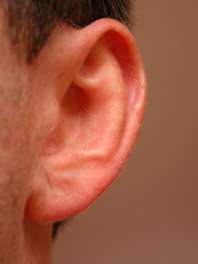New findings contradict a prevailing belief about the inner ear

A healthy ear emits soft sounds in response to the sounds that travel in. Detectable with sensitive microphones, these otoacoustic emissions help doctors test newborns' hearing. A deaf ear doesn't produce these echoes.
New research involving the University of Michigan and Oregon Health and Science University shows that, contrary to the current scientific thought, the emissions don't leave the ear the same way they entered. The findings give new insight into a phenomenon that researchers study to better understand hearing loss, and they reinforce a previous controversial study that came to a similar conclusion.
A paper on the research is published in the current issue of Proceedings of the National Academy of Sciences.
"The former wisdom on how otoacoustic emissions left the ear was that there was a backward-traveling wave going along the structure of the cochlea in the same way as the forward-traveling sound wave," said Karl Grosh, a professor in the U-M departments of Mechanical Engineering and Biomedical Engineering and an author of the paper. "These measurements show that is not the case."
Grosh said the next step is to develop tools to find out where hearing damage is occurring. "If we want to try to infer from the emission what's wrong with the ear, we have to understand how the emission is produced," Grosh said.
The experiment, performed at the Oregon Health and Science University in associate professor Tianying Ren's lab, showed that the sound waves coming out travel through the fluid of the inner ear, rather than rippling along the basilar membrane of the cochlea.
The cochlea, located deep in the ear, is shaped like a snail. The basilar membrane essentially cuts the inner channel of the cochlea diametrically in half into two chambers. Both chambers are filled with liquid.
Sound waves going into the ear undulate along the basilar membrane through the cochlea and eventually excite the organ of Corti, which senses and sends the sound signals to the brain through the auditory nerve.
Sounds coming out of the ear, according to results from this experiment, likely travel through the fluid on either side of the basilar membrane.
For this experiment, the researchers used laser interferometers, which detect waves, to measure vibrations of the basilar membrane in response to sound at two locations in the cochlea of gerbils. They detected evidence of sound waves traveling forward on the membrane, but they found no evidence of backward-traveling waves.
"Our new method can detect vibrations of less than a picometer, 1,000 times smaller than the diameter of an atom. The new data demonstrate that there is no detectable backward-traveling wave at physiological sound levels across a wide frequency range," said Ren, principal investigator of this project. "This knowledge will change scientists' fundamental thinking on how waves propagate inside the cochlea, or how the cochlea processes sounds."
The paper is called "Reverse wave propagation in the cochlea."
Source: University of Michigan


















